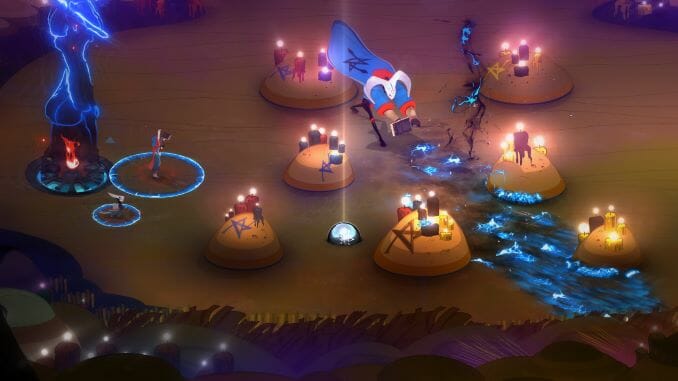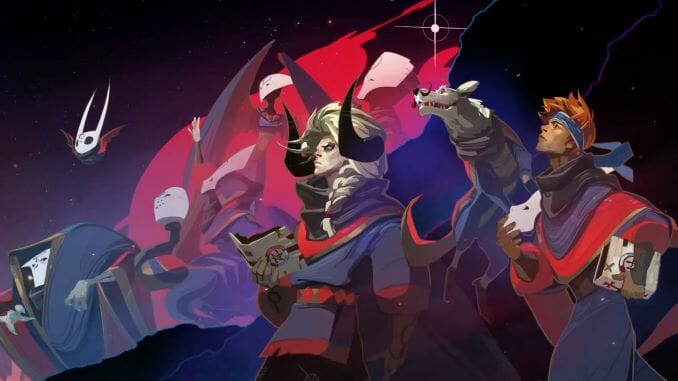Pyre has become the odd middle child of Supergiant’s oeuvre. Even before Hades turned the San Francisco based studio from an indie darling into a phenomenon, their third game was viewed as a turn away from the style of their first two, both more straightforward RPGs in more recognizable genre packages. Its central gameplay mechanic—basketball, if basketball became a way of escaping purgatory—was viewed as a radical departure from the structure of preceding games, which each included a customizable suite of weapons, upgrades, and challenges that allowed for wildly different gameplay experiences each time you played.
Pyre kept a lot of that customization. In fact, Pyre cemented it: do something twice and it’s a trend, but three times and it’s a calling card. The studio’s focus on story is present here, too, although Pyre is much more text-heavy than previous games, and that makes it a little slower. Most of the exposition comes from character dialogue that’s hyperlinked to expose you to even more of the history of the world, a form of purgatory called the Downside where teams of players compete to reach salvation and rejoin the world they were banished from. It’s more extensive than the rolling narration of previous games and, when alternated with Pyre’s fast-paced but carefully interstitial combat, just as digestible.
But despite these refinements of past games’ mechanics, Pyre is remembered primarily as the time Supergiant did a sports game. At the time, this was the major gripe with Pyre, and one of the reasons that despite its high review scores, it doesn’t have the same untouchable status as Supergiant’s previous two games, which—to me—don’t feel nearly as good to play now. It was fantasy sportsball, a left-field choice for a studio whose previous work had been a pastoral action RPG and a cyberpunk thriller. Both were more straightforward story-focused games with experience trees that created diverging playstyles, meaning that your gameplay experience could be novel each time you played.
Pyre is different. The sports game you play at the beginning is the sports game you’re playing at the end. The combat of Pyre is contained in a series of challenges called the Rites, where three-person teams compete to plunge an orb into their opponent’s goal and prevent the same from happening to them. On a replay there are many ways to make it harder, but if you like the basketball-like combat the first time you do it, chances are you’ll like it the twentieth; if not, the same is true.
The removal of weapons management as a way of creating variety obscured the fact that this is yet another mechanic Pyre adapts from earlier games, just in a different form. Each of the members of your team, the Nightwings, has their own playstyle and specialty: some of them are adept at banishing other players from the field, while others are better at jumping into the opposing player’s pyre and scoring points. They are your weapons, each suited to something different on the field. You don’t have to use all of them, but you’ll use most. All of them have their own backstories: they’ve been banished from the surface world into this purgatory for some reason, and they all have a reason they’d like to return, from resuming their jobs to seeing their families again. Each person you save will also have a role to play in the revolution brewing in the Commonwealth against the overly religious, anti-literacy government that has cast you all down.
Pyre’s revelation about a third of the way through is that your battles have been in service of a larger plot element the entire time. You do not just escape wholesale from the Downside when you win the Rites; only one player can go, and it’s the player you’ve used the most. Whoever has the most experience—and, because of how Pyre drip-feeds storytelling as characters level up, whoever you’ve learned most about—will be the first to go. Even if you win every match, only so many of your players can escape, but once they do they’re gone for good.

What if your weapons could leave you? Pyre teaches you, many hours in, the danger of treating characters like pure game mechanics. For me, the player I used the most was also the character I liked the most: Rukey, a small shifty dog who can leap over enemies to reach the pyre. He wasn’t a big scorer, but was easy to use, and was with the Nightwings from the beginning, meaning I had lots of practice with him. Another of the original three, Jodariel, never made it out. She was too slow, and I ended up using her only when I had so few players left on my team that I needed her to stand by the goal and pray no one would jump past her. She wanted to return. I couldn’t get her there.
Ultimately, the way Pyre ties its characters’ arcs so firmly to their mechanics as players in the Rites is an extension of the game’s ethos as a whole: it is Supergiant’s shift from a narrative focused on a disembodied narrator’s relationship to the player to one focused on the player’s relationship to a cast of NPCs. This trajectory continues with Hades, which famously has a dialogue system complex enough to generate new conversations hundreds of hours in. Hades itself is the most lauded of Supergiant’s games; two years on, the studio is on a break from that game’s development and has yet to announce a new project. It is a refinement of all the other games’ systems, a tight collection of gameplay and story that talk back to each other seamlessly, in a roguelike package that just feels good to play. Pyre is the place this interconnection of NPC relationships with combat was solidified. Without Pyre, there’s no Hades.
In her review of Pyre in 2017, Julie Muncy compared it to Jon Bois’s football epic 17776, another meditation on sports as leisure: “Pyre imagines a life similarly obsessed with competition, just for the precisely opposite reasons… [as] our only means of transcending conflict and risk gone too far.” While the Rites are a matter of life and death for their players, some treat them as an opportunity to have fun; at the same time, as in Bois’s football utopia, there is a devastating undercurrent of recurrence without change. Though some people get out, “in your case,” the judge of the Rites says early on, “I hardly think it possible”—and for you, this proves to be true.
Pyre is ultimately about how you build a revolution. Depending on who you save, it can be peaceful or violent, it can fail, or it can accomplish goals contrary to what you wanted. Sports are the vehicle toward forming that revolution, but here, at least, they both have the same requirements: passion, social chemistry, a shared desire to work toward a common goal. As you lose players, you’re gaining an anti-team somewhere above, whose work you can’t influence or, for the most part, even see. In this way Pyre is also about the kind of optimism needed for long-term action, things smaller than but as foundational as revolutions.
What sort of a person would you have to be to work for the liberation of others when your own is out of reach? This is a question Supergiant has always been interested in. Each of their games, in their own way, is about someone searching to change a situation they’re powerless to escape from themselves. Characters can only access their limited, partial salvation by immersing themselves in the fate of those around them, something that comes through clearly in the end-credit songs the studio is known for: the ambivalent, Evangelion-esque “We All Become” in Transistor, or Zagreus’s unasked-for reunion with his family in Hades’s “In the Blood,” or here, in Pyre, in “strands that break alone, but twisted make a braid.” Your function in all these stories is to work for the future freedom of the people around you, irrespective of your own place in that future.
Like Supergiant’s previous work, Pyre remains hopeful about the possibility for selfless action even in the most repetitive and desolate environments. This is clearly seen in one of the most interesting mechanics it employs, unique among the studio’s work up to that point: you continue in the story regardless of whether you win. Even if none of your teammates escape, even if you lose every battle, the game will continue, and the characters doomed to stay will go on to make the Downside a better place. My Jodariel, for example, spent her life assisting those who had to stay, improving living conditions for everyone else there. The revolution was unsuccessful in the end, but there were still some small changes that made life in purgatory slightly more livable.
When I played Pyre the first time, this seemed like a capitulation. Surely failing to escape was exactly that—a failure, not an opportunity. Five years on, I find myself more moved by Pyre’s admission that large scale goals can fail, hopes can be dashed, and people can still make small changes that improve the lives of those around them. While Pyre’s plot is the most overtly revolutionary of all of Supergiant’s games so far, its emphasis is ultimately much smaller, quieter, and for me, more resonant: it’s up to us to care for each other, win or lose. We all, eventually, move as one.
Emily Price is an intern at Paste and a columnist at Unwinnable Magazine. She is also a PhD Candidate in literature at the CUNY Graduate Center. She can be found on Twitter @the_emilyap.

